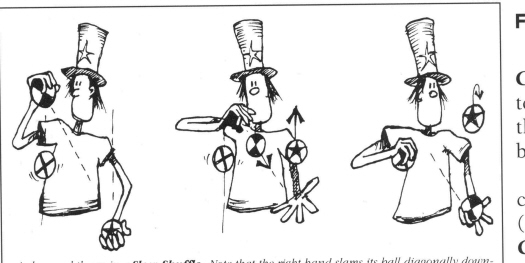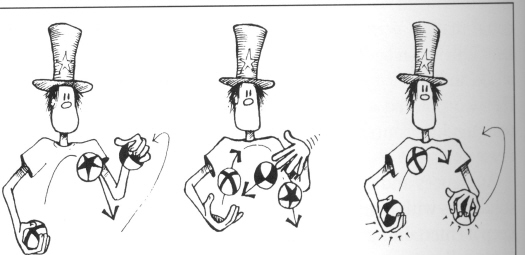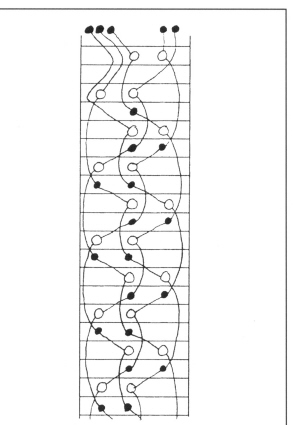|
Juggler's Workshop Charlie
Dancey's Encyclopaedia of Ball Juggling
This time we're reprinting, with the kind permission of the publisher, Butterfingers of Bath, England, selected entries from Charlie Dancey's Encyclopaedia of Ball Juggling (which is reviewed elsewhere in this issue). Items in bold are cross references to other entries in the book, though not all referenced entries are reprinted here. Note also that we're not printing these entries in the alphabetical order in which they appear in the book. - Martin Frost
Bouncing
Beast The
Bouncing Beast is a curious creature that you can fashion
from six Bouncing Balls. This is not a juggling trick, just
something weird and wonderful that you can do!
You
need six balls (ideally silicone) and a smooth floor. Make a
Pyramid with four balls, which will hold together due to the
high surface friction of the balls. This is the beast's head. Now
locate a fifth ball in the centre of one face of the pyramid - this
is the body.
The
sixth ball is placed between the fifth ball and the floor, forming
the tail. Let go of everything and the Bouncing Beast will
stay intact with the body forming a bridge between the head and the
tail.
Now
gently stroke the body in the direction of the Bouncing
Beast's tail and the whole structure will roll across the floor
as a unit. Incredible!
Slow
Shuffle The
Slow Shuffle is the infinitely easier first cousin to the
Shuffle. The trick is so named because it resembles the action
of shuffling a pack of cards.
Juggle
Two in One Hand, in columns, in your left hand. Hold the
third ball in your right hand. Position your right hand so that the
middle ball peaks just below it.
As
the middle ball reaches the top of its flight you make a snappy
exchange. Your right hand slams its ball diagonally downwards
directly into the left hand then immediately snatches the
middle ball out of the air.
This
is one of those tricky knacksome moves. It's odds on that on your
first attempt you will succeed merely in flinging a ball hard at the
floor!
With
a little perseverance and a few rounds of the Yo-yo mixed in
for light relief you will get there! Once you can do a single Slow
Shuffle you should practise making one exchange on every
other left hand throw. That's the trick!
The
difficult version, the Shuffle itself, has you making one of
these exchanges on every left hand throw.
The
Slow Shuffle looks very good if you juggle it on alternate
sides. First you make
a slam exchange on the
Curiously,
there is quite a close relationship between the alternate-sided Slow
Shuffle and the very simple three ball pattern, Arches.
If you juggle Arches by slamming the 'middle' ball downwards
you get more or less exactly the same pattern!
Shuffle The
Shuffle is a difficult three ball pattern with an action that
resembles a pack of cards being shuffled. It's difficult because the
key throw, the throw that gives the pattern its shape and style, is hard
and downwards. Miss that catch and the ball hits the
floor before you even notice that you've dropped it! The Shuffle
is a shape distortion of the three ball Half Shower. It might be
best to learn the much easier Slow Shuffle first.
Warm
up by throwing a hundred rounds of a left-handed three ball Half
Shower . The left hand throws 4's to the right while the right
throws 2s to the left-both hands throwing simultaneously.
To juggle the Shuffle you just (ha!) change the shape of the pattern so that those right hand 2's are thrown from top right to bottom left, over the approaching ball. The right hand catch requires very quick and precise movement. The balls move in a figure eight pattern, the right hand does most of the work and the left hand hardly moves at all.
Five Ball Column Bounce If
you can do a Four Ball Column Bounce you'll be able to learn
this - even if you never thought of yourself as a five ball juggler!
Five
balls are juggled in three columns using the easy peasy (once you've
got the knack)
Start
by placing three balls in your left
hand and two in the right. This is a slightly
unusual start, since the first move is e to the right.
Imagine
three columns before you, right, middle and left.
The
first two (simultaneous) throws are made in the right and middle
columns, then you sweep to the left and throw into the left and
middle columns (at this stage your right hand is making the first exchange).
Then
you sweep right again and make exchanges in the right and middle
columns. Thus the pattern continues, sweeping to the left
and right alternately. On every
throw a ball is delivered into the middle column.
All
three columns rise and fall in synch and on every bounce three balls
hit the floor. The balls in the outside columns bounce twice and the
ball in the middle column bounces once. The trick is to keep those
balls moving absolutely vertically, which means no
sideways movement of the hands at all at the instant of the
throw.
When you can juggle a solid Five Ball Column Bounce you are ready for the even more incredible Six Ball Column Bounce which is juggled using the same technique, but in four columns instead of three.
|





